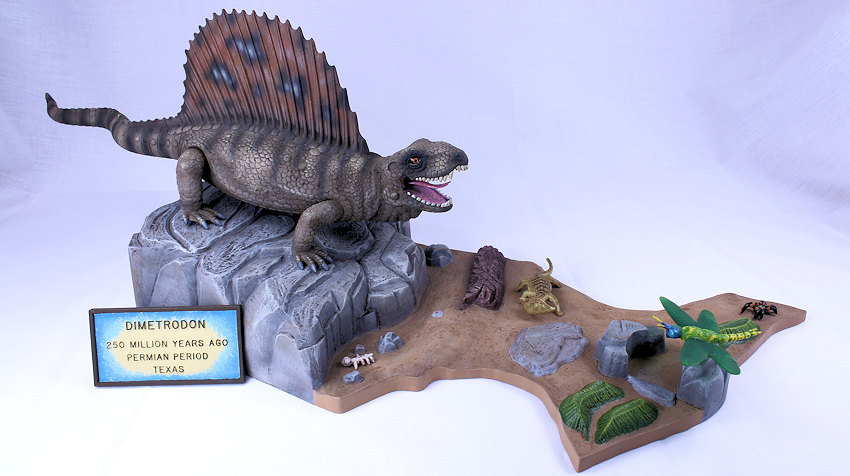
Aurora 'Sail Back Reptile' (Dimetrodon)
| KIT #: | 745 |
| PRICE: | $Long out of production |
| DECALS: | N/A |
| REVIEWER: | Scott Lyle |
| NOTES: |

| HISTORY |
Sporting jaws full of fearsome teeth and a massive fin on its back, Dimetrodon lived nearly 300 million years ago during the Permian period. Usually identified in popular culture as a dinosaur, Dimetrodon was actually a “mammal-like reptile” that died out some 40 million years before the first dinosaurs even appeared. Reaching lengths upward of 13 feet, Dimetrodon probably hunted reptiles and amphibians on land near water though some scientists believe it lived an aquatic or semi-aquatic existence.
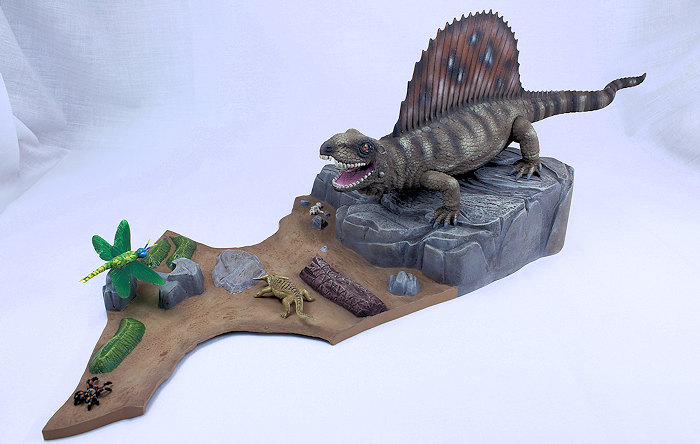 The biggest mystery
surrounding the creature remains the purpose of that sail however. Various
theories regarding its purpose have been put forth; it could have helped the
animal hide in foliage or regulate its body temperature. Some have suggested
that it could have actually used its sail as a way to have wind propel it
through the water – yes, like a sail boat. More recent theories give the
sail a more romantic purpose – sexual selection. Perhaps in the Permian
period size did matter and the Dimetrodon with the biggest sail got to make
more babies than the others!
The biggest mystery
surrounding the creature remains the purpose of that sail however. Various
theories regarding its purpose have been put forth; it could have helped the
animal hide in foliage or regulate its body temperature. Some have suggested
that it could have actually used its sail as a way to have wind propel it
through the water – yes, like a sail boat. More recent theories give the
sail a more romantic purpose – sexual selection. Perhaps in the Permian
period size did matter and the Dimetrodon with the biggest sail got to make
more babies than the others!
Whatever the purpose of the sail, it is beyond debate that the Dimetrodon was a truly unique creature and as such, has been kitted by a few different model companies. Life-Like and Airfix issued kits back in the day, as did Aurora.
| THE KIT |
Ahh, Aurora…My lifelong love affair with plastic
models began with Aurora’s Prehistoric Scenes series of kits. Aurora
pioneered the “diorama kit” as it were, starting with their extremely
popular line of movie monsters that debuted in 1961. From there they moved
on to super heroes and TV stars, and even American wildlife. In the early
1970s they came out with their Prehistoric Scenes line, a series of 17 kits
t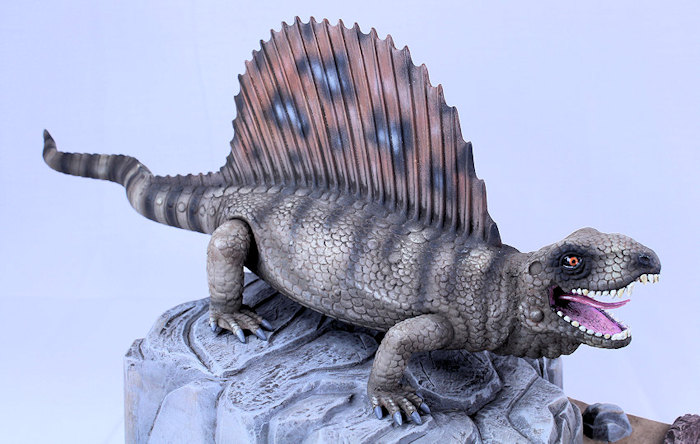 hat featured dinosaurs, prehistoric mammals, and cave people set in
realistic diorama bases complete with plastic trees, plants, snakes, bugs,
bones and anything else that seemed appropriate.
hat featured dinosaurs, prehistoric mammals, and cave people set in
realistic diorama bases complete with plastic trees, plants, snakes, bugs,
bones and anything else that seemed appropriate.
The bases all interlocked together to create a huge sprawling primeval scene. Chronological correctness mattered not to Aurora – if you set the kits up as Aurora intended the Styracosaurus was next to the Woolly Mammoth which was next to the Neanderthal Man which was next to the Pteranodon and so on. No explanation was ever offered for box art showing an Allosaurus terrorizing our primitive ancestors in their cave home – it was all in good fun.
The kits were meant to be toy-like. They all snapped together with no glue so any kid could build them in a second, paint them, and then set them up. The arms, legs, jaws, and tails all moved, and that combined with the aforementioned diorama settings made the kits more like play-sets than models. I can tell you my Cro-Magnon Man still bears the scars of being wedged in my Allosaurus’ mouth a few too many times.
A
dinosaur-loving tyke like my 6 year-old self could not help but be sucked in by
the dramatic box art on those colorful boxes. I had them all, and in fact still
have them all after all these years, though they are now in rather poor shape
having been chucked into a box and moved around more times than I care to
remember. For about 25 years now I’ve been planning on building a large diorama
featuring them, and
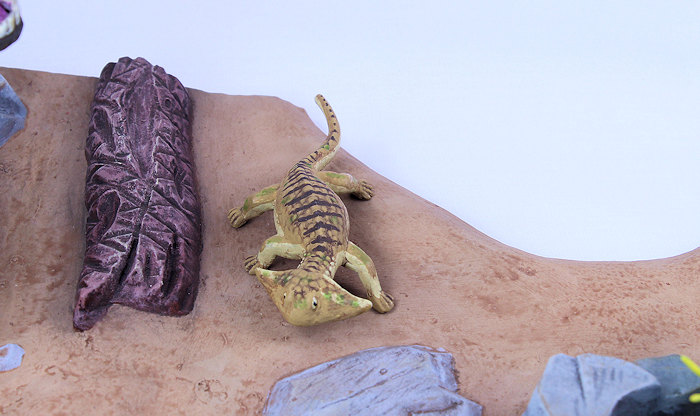 I’ve finally resolved to start doing it. To start “Operation
Aurora Resurrection” (wow I’m a nerd…) I decided to begin with the “Sail Back
Reptile” (Dimetrodon).
I’ve finally resolved to start doing it. To start “Operation
Aurora Resurrection” (wow I’m a nerd…) I decided to begin with the “Sail Back
Reptile” (Dimetrodon).
One of the later offerings in the line, the kit features the Dimetrodon perched on a rocky outcropping overlooking a swamp. Aurora includes a prehistoric-looking lizard, a large dragonfly, and a large spider as potential Dimetrodon meals. Not satisfied to stop there, Aurora engineered a pair of rocks on the base between which you could wedge a large palm tree from another kit in the line, the “Jungle Swamp”. Always thinking those Aurora guys were…
Monogram fans know that when Aurora went out of business in 1976, Monogram acquired several of the molds, including the Prehistoric Scenes kits. Over the years Monogram reissued several of the Prehistoric Scenes kits, including this one a couple of times. When Monogram was acquired in turn by Revell the molds moved once again, and Revell has since reissued the Sail-Back Reptile, most recently in 2010. As the saying goes, old molds never die. Or is it “dead molds tell no tales?” I forget. Let’s build the thing.
| CONSTRUCTION |
Since the
Dimetrodon had been “snapped together” some forty years ago I began by
taking all of the pieces apart and cleaning up any flash or sprue attachment
points. I then snipped all of the large snap-together pins off. There were
smaller pins on the edges of the parts that did a better job aligning the
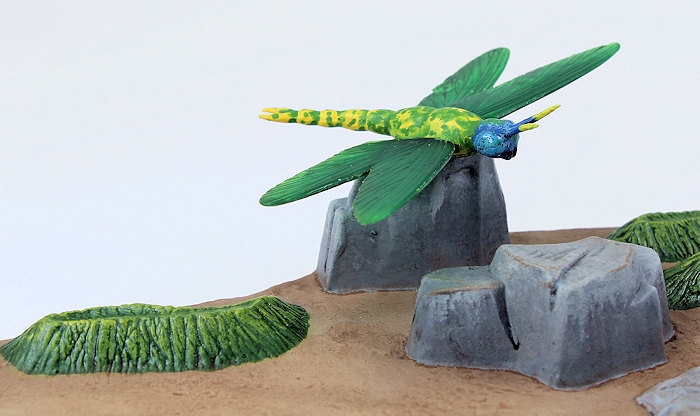 various parts together than did the snap-together pins. I then glued all of
the parts together. If I had assembled it as Aurora intended the tongue
would have been left free to waggle up and down, the jaws to open and close,
the entire head to move up and down, all four legs to pivot around, and the
tail to swing back forth. But of course I am a serious
modeleur
now and cannot have such silliness in my creations.
various parts together than did the snap-together pins. I then glued all of
the parts together. If I had assembled it as Aurora intended the tongue
would have been left free to waggle up and down, the jaws to open and close,
the entire head to move up and down, all four legs to pivot around, and the
tail to swing back forth. But of course I am a serious
modeleur
now and cannot have such silliness in my creations.
The inevitable seams were sanded down with flexible filing sticks, but they actually weren’t too bad. Some Squadron putty was needed here and there for the seams, and I used a fair amount to coat the upper and lower surfaces of the mouth to create a gnarly reptilian look. With so few parts it only took a couple of nights and my Dimetrodon was resurrected and ready for paint.
| COLORS & MARKINGS |
Before painting I hunted around online for a good artist’s rendition of a Dimetrodon that I could use as a painting guide. With that in hand I first primed the beastie with Tamiya’s Fine Surface Primer and then pre-shaded the recessed areas and wrinkles in the dinosaur’s skin with some Tamiya XF-64 Red Brown. For the base color on the body I made a custom mix of 50/50 Tamiya XF-49 Khaki and XF-72 JGSDF Brown and sprayed that in light coats to let the pre-shading show through. I then lightened that with some Tamiya XF-55 Deck Tan and sprayed the high points and upper surfaces to add some variation. I sprayed the sail Testors Earth Red, and then added some random splotches using Tamiya NATO Black and Deck Tan. Finally I added some tiger stripes along its back using Tamiya XF-69 NATO Black.
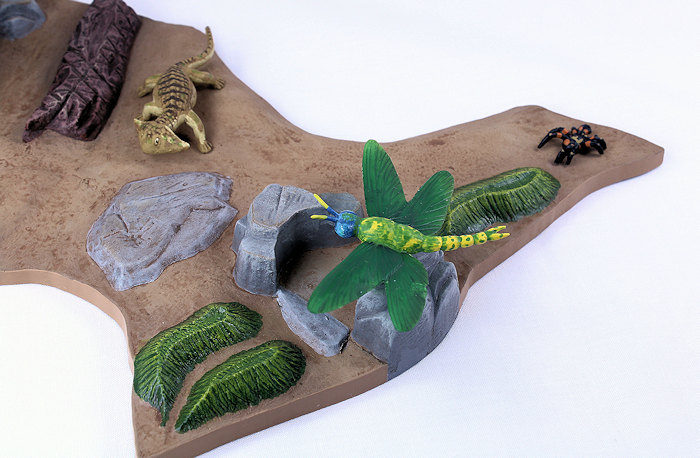 Up next an overall wash of
MIG Productions’ Dark Wash was brushed over the whole model, and then some dry
brushing was applied using Vallejo Dark Tan. All of those scales and bumps cast
into the dinosaur’s skin are tailor-made for some dry brushing. To finish my
Dimetrodon off I painted his teeth a light beige color and the mouth pink. The
eyes were painted black with an orange iris and black pupil, giving him a rather
evil look.
Up next an overall wash of
MIG Productions’ Dark Wash was brushed over the whole model, and then some dry
brushing was applied using Vallejo Dark Tan. All of those scales and bumps cast
into the dinosaur’s skin are tailor-made for some dry brushing. To finish my
Dimetrodon off I painted his teeth a light beige color and the mouth pink. The
eyes were painted black with an orange iris and black pupil, giving him a rather
evil look.
The next task was to paint the base, which was also primed and then pre-shaded using Tamiya NATO Black. I then made a custom mix of 50/50 Tamiya XF-15 Flat Flesh and XF-72 JGSDF Brown for the base color of the earth, while the rocks were painted Tamiya XF-19 Sky Gray. The other base details were picked out by hand before a wash of MIG Productions Dark Wash was brushed over the thing. Some subtle dry brushing helped bring more life to the rocks, grass, and fallen log.
I should mention that at some point in my youth I thought it prudent to cut away the small section of water that was originally molded into the base. That seems dumb now, but it did save me the trouble of trying to paint plastic water. Instead I just needed to paint the reptile, tarantula, and large dragonfly - which by the way, can we all be thankful that those things no longer exist? Talk about being straight out of a horror movie. The “save all the species” folks are all wrong – in this case it’s a good thing that some species went extinct.
When the paint was dry I had finally rebuilt and updated one of the old models from my childhood that had been literally collecting dust for some forty years. One down, sixteen more to go.
| CONCLUSIONS |
A break from my normal military subjects, a trip down memory lane, a surprisingly fun build? Actually, all of the above. If you’re into dinosaur kits then you already know all about these old Aurora kits. If you’re not, they’re a great way to try some new painting techniques and experiment with some new color schemes. Maybe you’re an old model hoarder like me and you have some stashed away in an attic somewhere. Don’t let that classic plastic go to waste, try your hand at your own model resurrection.
| REFERENCES |
- Wikipedia, the Online Encyclopedia
April 2016
Copyright ModelingMadness.com